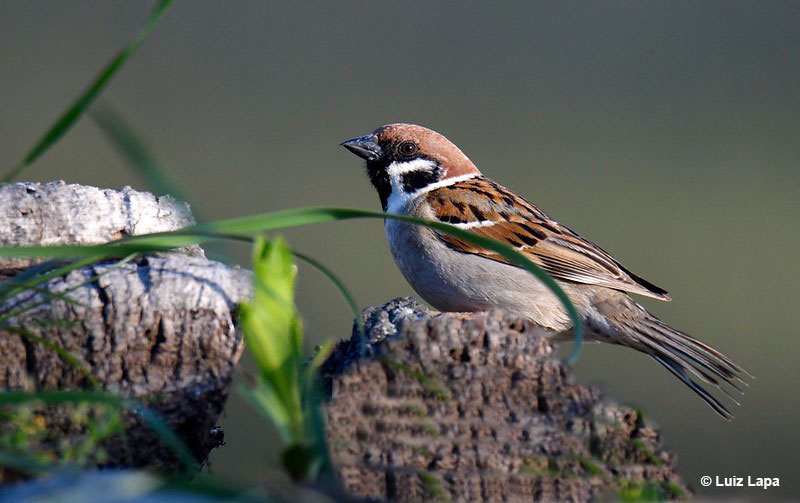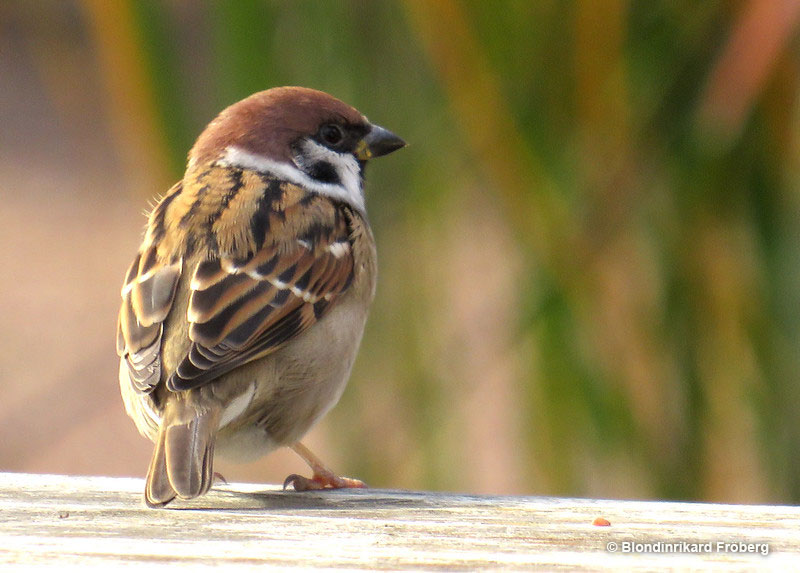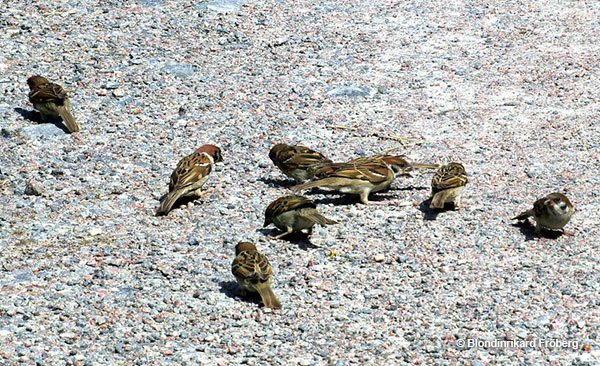The Eurasian Tree Sparrow (Passer montanus) may look like just another small brown bird, but don’t be fooled!
This common but charismatic bird can be found throughout Eurasia, from the United Kingdom to Japan. Despite being similar in appearance to the House Sparrow, the Eurasian Tree Sparrow can be distinguished by its distinct chestnut crown and black patch on its white cheek.
Their adaptable nature means they can thrive in a variety of habitats, from urban environments to rural farmland.
Identification
The Eurasian Tree Sparrow is a small songbird with a round head, short neck, and thick conical bill. It is 5—5.5 inches long, has a wingspan of 8.3 inches, and weighs around 0.85 ounces.
Both males and females have similar plumage and can’t be distinguished by looks alone. Juvenile Eurasian Tree Sparrows look very similar to adults, the only difference being that they’re duller in color.
It has a chestnut cap and black face with a black spot set in a white cheek, a kidney-shaped black ear patch, and light brown streaked wings with two narrow white bars. Its upperparts are light brown streaked with black and its underside is light gray. The legs are pale brown and bill lead-blue in summer that goes almost black in winter.
These birds have various vocalizations but don’t sing. Eurasian Tree Sparrow’s calls are different loud chirps. Unpaired or courting males give an excited series of tscips, flight calls are harsh tecks and other monosyllabic chirps are used in social contexts.
Both sexes give a sweet chip call that you can often hear when they’re foraging in flocks.
You can meet this bird foraging alone or in flocks in farmlands, pars, villages, and lightly wooded areas.
Food
The Eurasian Tree Sparrow’s diet mainly consists of various types of seeds, such as chickweeds and goosefoot, and grains. They also visit bird feeders.
During the breeding season, when the young are fed mainly on animal food, the Eurasian Tree Sparrow eats insects, woodlice, millipedes, centipedes, spiders, and harvestmen. They forage on the ground in flocks, often with house sparrows, finches, or buntings.
During winter, seed resources are likely scarcer, and individuals in a flock form a linear dominance hierarchy. Adults forage in various wetlands and aquatic habitats for invertebrate prey to feed nestlings.
Eurasian Tree Sparrows forage mostly while hopping on the ground, but they may also feed up in shrubs or trees at times. They often forage in flocks and you might see the ones in the rear fly to the front of the flock to feed on new ground.
Around agricultural areas, they consume oats, rye, wheat, corn, sunflower, and sorghum, and they also eat ripe berries, flowers, leaf buds, and new plant shoots.
In North America, the diet of the Eurasian Tree Sparrow is not known in detail, but it undoubtedly includes the seeds of various weeds and grasses, as well as waste grain in fields. They also eat many insects, especially in summer.
Nesting and Eggs
The Eurasian Tree Sparrow is capable of breeding within a year of hatching and usually constructs its nest in a hole in an old tree or building. The bird can breed in isolation or in loose colonies and will readily use nest boxes.
During the breeding season, the male Eurasian Tree Sparrow chooses the nest site, advertises his ownership, and tries to attract a mate by calling from near the nest site.
He may also bring nesting material into the hole. Both the male and female Tree Sparrows build the nest, which is a messy cup or sphere made of hay, grass, and straw lined with feathers, cloth, and other soft fine material. The nest’s dimensions vary depending on the size of the cavity in which it is built.
The typical clutch consists of five to seven white to pale grey eggs that are heavily marked with spots, small blotches, or specks. The eggs are about 0.79 in × 0.55 inches in size.
Both parents incubate the eggs for 12-13 days before the chicks hatch, and another 15-18 days elapse before they leave the nest. The bird may raise two or three broods each year.
Current Situation
Eurasian Tree Sparrow’s range covers most of Eurasia. In North America, its range covers a little area around northeastern Missouri, southeastern Iowa, and west-central Illinois. In 1870, it was released in Missouri and settled there along with European migrants and has since stayed there. The North American population is non-migratory.
Eurasian Tree Sparrow’s habitats include farmlands and towns. In North America, they prefer open country with scattered trees and bushes. You can find them in hedges, parks, and farms.
These sparrows are listed as of least concern in the IUCN Red List with its population reaching a couple hundred million. Its numbers are decreasing in Europe due to changes in agricultural practices, including different sowing times and the use of pesticides and herbicides, leading to a decrease in food.
Facts
- In numerous regions across the globe, there have been documented cases of crossbreeding between the Eurasian Tree Sparrow and the House Sparrow. Typically, the male hybrids exhibit physical characteristics more similar to the Eurasian Tree Sparrow, whereas the female hybrids bear greater resemblance to the House Sparrow.
- Eurasian Tree Sparrows have different feeding strategies depending on the distance between shelter and food and the possibility of meeting a predator. The further away the feeding spot, the smaller the flocks and the less time they spent foraging, staying more vigilant in the process. If the chance of falling prey was higher, for example in more open areas, they opted to join others who had already discovered food.
- Reproductive productivity depends on whether the pair breeds in a colony or not. Birds breeding in colonies produce more eggs from their first broods. However, birds breeding alone produce more offspring from their second and third clutch.
- Eurasian Tree Sparrows are not native to North America. They were introduced to Missouri in 1870 with the population still existing today. However, the attempts to establish them in New Zealand in 1868 were unsuccessful.
Similar Species
We’ve introduced two similar sparrow species.
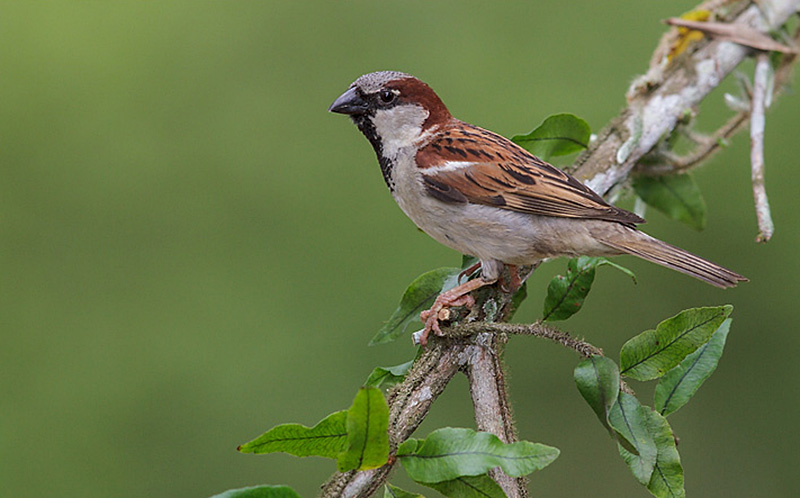
House Sparrow (Passer domesticus) perched on a branch in the Atlantic rainforest of southeast Brazil.
Eurasian Tree Sparrows and House Sparrows are quite similar with their brown-and-black striped upperside and light grayish underside.
However, Eurasian Tree Sparrows have a black patch on their otherwise white cheek and lack the gray crown the breeding male House Sparrow has.
House Sparrows also have a larger black throat patch.
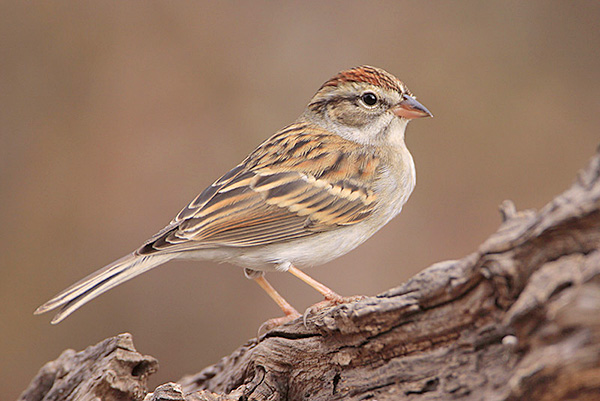
Chipping Sparrow
Breeding Chipping Sparrows are smaller and have a rusty crown and gray face with a black eye line instead of a black cheek patch.
Non-breeding Chipping Sparrows also lack the black on their face and have that distinct chestnut crown and light beige face with a black eye line.
People Also Ask
How common are Eurasian Tree Sparrows?
Eurasian Tree Sparrows are very common in Eurasia with over a 38 million square mile range and a population of 190-310 million mature individuals. Their range in North America is rather small.
What is the difference between a Eurasian Tree Sparrow and a House Sparrow?
Eurasian Tree Sparrow has a black patch on their white cheek and they lack the gray crown the breeding male House Sparrow has.
What do Eurasian Tree Sparrows eat?
Eurasian Tree Sparrows eat mainly seeds and grains, but they also catch insects during the breeding season.
Are Eurasian Tree Sparrows invasive?
In some areas, they are seen as pests and may be considered invasive, since they can be aggressive towards native birds.
Are Eurasian Tree Sparrows aggressive?
Eurasian Tree Sparrows are fierce and aggressive, although not as aggressive as House Sparrows. They can be quite persistent about claiming a nesting site.

